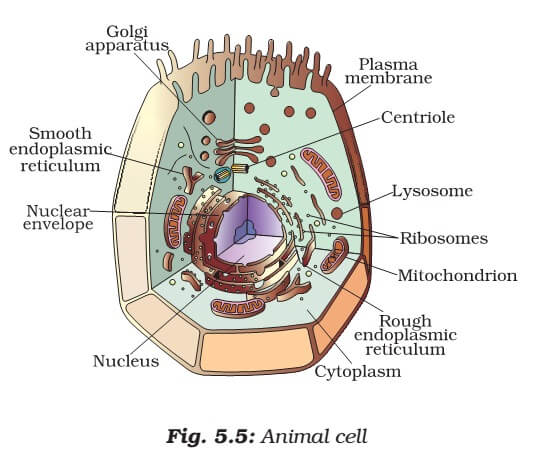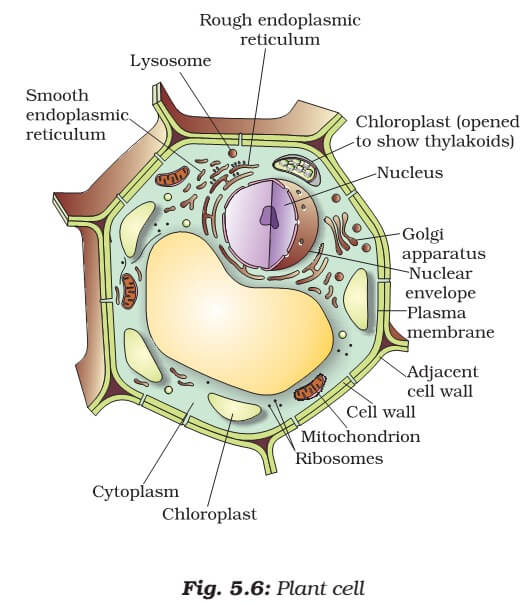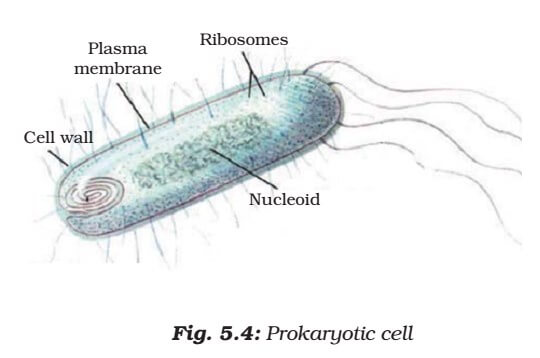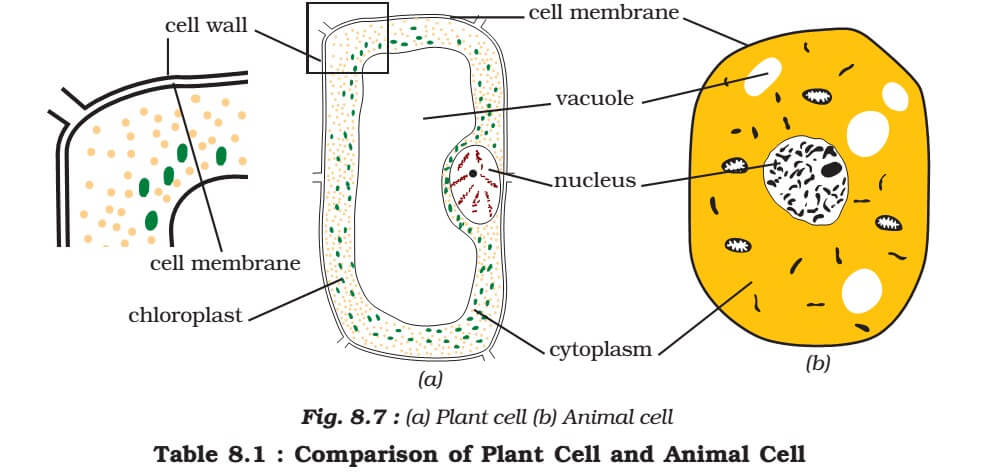What Two Organelles Do Plant Cells Have That Animal Cells Do Not
Prison cell – Cell Organelles: Plasma Membrane, Jail cell Wall, Cytoplasm, Nucleus, Mitochondria. Prokaryotic Cells vs. Eukaryotic Cells. Plant Cell vs. Animal Cell.
Compiled from NCERT Scientific discipline Textbooks Form 6-12.
Watch Video for Easy Agreement
Cell
| Robert Hooke | Discovered and coined the term cell in 1665 |
| Robert Brown | Discovered Cell Nucleus in 1831 |
| Schleiden and Schwann | Presented The prison cell theory, that all the plants and animals are equanimous of cells and that the cell is the basic unit of life. Schleiden (1838) and Schwann (1839). |
- With the discovery of the electron microscope in 1940, information technology was possible to discover and empathise the complex structure of the cell and its various organelles.
Cell Organelles


Plasma Membrane or Cell Membrane
- Cell membrane is also called the plasma membrane.
- It can exist observed only through an electron microscope.
- Plasma membrane is the outermost roofing of the cell that separates the contents of the jail cell from its external environment.
Endocytosis
- The plasma membrane is flexible and is made up of organic molecules called lipids and proteins.
- The flexibility of the cell membrane also enables the prison cell to engulf in food and other cloth from its external surroundings. Such processes are known as endocytosis (endo → internal; cyto → of a cell). Amoeba acquires its food through such processes.
Diffusion
- Plasma membrane is a selectively permeable membrane [The plasma membrane is porous and allows the movement of substances or materials both inwards and outward].
- Some substances like carbon dioxide or oxygen can motion across the cell membrane by a procedure called diffusion [spontaneous move of a substance from a region of high concentration (hypertonic solution) to a region where its concentration is low (hypotonic solution)].
- Thus, diffusion plays an important office in gaseous exchange between the cells too as the prison cell and its external surroundings.
Osmosis
- Water also obeys the law of diffusion. The movement of water molecules through a selectively permeable membrane is chosen osmosis.
- Osmosis is the passage of water from a region of high water concentration through a semi-permeable membrane to a region of low h2o concentration. Thus, osmosis is a special example of diffusion through a selectively permeable membrane.
- Unicellular freshwater organisms and most constitute cells tend to gain water through osmosis. Absorption of water by institute roots is also an case of osmosis.
- Thus, diffusion is of import in exchange of gases and water in the life of a cell. In additions to this, the jail cell likewise obtains nutrition from its environment.
- Different molecules motility in and out of the cell through a blazon of ship requiring use of free energy in the form of ATP.
Reverse Osmosis (RO)
- Reverse osmosis (RO) is a water purification technology that uses a semipermeable membrane to remove larger particles from drinking water.
- In opposite osmosis, an applied pressure is used to overcome osmotic force per unit area.
- Reverse Osmosis is a phenomenon where pure water flows from a dilute solution [hypotonic] through a semi permeable membrane to a higher full-bodied solution [hypertonic].
- Semi permeable ways that the membrane volition allow small molecules and ions to laissez passer through it but acts as a barrier to larger molecules or dissolved substances.
Cell Wall
- Cell wall is absent in animals .
- Constitute cells, in addition to the plasma membrane, have another rigid outer covering called the cell wall. The jail cell wall lies outside the plasma membrane.
- The plant cell wall is mainly composed of cellulose. Cellulose is a complex substance and provides structural force to plants.
Plasmolysis
- When a living plant prison cell loses water through osmosis in that location is shrinkage or contraction of the contents of the cell away from the jail cell wall. This miracle is known as plasmolysis (plasma → fluid; lysis → disintegration, decomposition).
- Just living cells, and not expressionless cells, are able to absorb water by osmosis. Cell walls permit the cells of plants, fungi and bacteria to withstand very dilute [hypotonic] external media without shrinkage.
- In such media the cells tend to lose water by osmosis. The cell shrinks, edifice upwardly pressure against the cell wall. The wall exerts an equal pressure confronting the shrunken cell.
- Prison cell wall also prevents the bursting of cells when the cells are surrounded by a hypertonic medium (medium of high concentration).
- In such media the cells tend to gain h2o past osmosis. The cell swells, building upwardly pressure confronting the cell wall. The wall exerts an equal force per unit area against the swollen cell.
- Because of their walls, plant cells can withstand much greater changes in the surrounding medium than animal cells.
Cytoplasm
- It is the jelly-like substance present betwixt the prison cell membrane and the nucleus.
- The cytoplasm is the fluid content inside the plasma membrane.
- Information technology as well contains many specialized cell organelles [mitochondria, golgi bodies, ribosomes, etc].
- Each of these organelles performs a specific function for the cell.
- Cell organelles are enclosed by membranes.
- The significance of membranes can be illustrated with the example of viruses.
- Viruses lack any membranes and hence practice non bear witness characteristics of life until they enter a living body and use its cell machinery to multiply.
Nucleus
- Information technology is an important component of the living prison cell.
- It is generally spherical and located in the center of the cell.
- It can be stained and seen easily with the help of a microscope.
- Nucleus is separated from the cytoplasm past a double layered membrane called the nuclear membrane.
- This membrane is also porous and allows the movement of materials between the cytoplasm and the within of the nucleus [diffusion].
- With a microscope of college magnification, we tin meet a smaller spherical body in the nucleus. It is called the nucleolus.
- In addition, nucleus contains thread-similar structures called chromosomes. These carry genes and help in inheritance or transfer of characters from the parents to the offspring. The chromosomes can be seen only when the cell divides.
- Gene is a unit of inheritance in living organisms. It controls the transfer of a hereditary characteristic from parents to offspring. This means that your parents pass some of their characteristics on to yous.
- Nucleus, in improver to its function in inheritance, acts as control eye of the activities of the prison cell.
- The entire content of a living cell is known as protoplasm [cytoplasm + nucleus]. Information technology includes the cytoplasm and the nucleus. Protoplasm is chosen the living substance of the cell.
- The nucleus of the bacterial cell is non well organized like the cells of multicellular organisms. There is no nuclear membrane.
- Every cell has a membrane around it to keep its own contents split from the external environment.
- Big and circuitous cells, including cells from multicellular organisms, demand a lot of chemical activities to support their complicated structure and office.
- To keep these activities of different kinds separate from each other, these cells use membrane-bound niggling structures (or 'organelles') inside themselves.
Chromosomes
- The nucleus contains chromosomes, which are visible every bit rod-shaped structures but when the cell is about to split up.
- Chromosomes incorporate information for inheritance of features from parents to next generation in the course of Deoxyribonucleic acid (deoxyribo nucleic acid)
- Chromosomes are composed of DNA and Protein.
- DNA molecules contain the information necessary for constructing and organizing cells. Functional segments of dna are called genes.
- In a jail cell which is not dividing, this dna is present as part of chromatin textile. Chromatin textile is visible equally entangled mass of thread similar structures. Whenever the jail cell is about to dissever, the chromatin material gets organised into chromosomes.
- The nucleus plays a central role in cellular reproduction, the process past which a unmarried cell divides and forms two new cells.
- It also plays a crucial part, along with the environment, in determining the way the cell will develop and what form it will exhibit at maturity, by directing the chemic activities of the cell.
Prokaryotic Cells vs. Eukaryotic Cells
- Organisms whose cells lack a nuclear membrane, are called prokaryotes (pro = primitive or main; karyote ≈karyon = nucleus).
- Organisms with cells having a nuclear membrane are called eukaryotes.
- Prokaryotic cells too lack most of the other cytoplasmic organelles present in eukaryotic cells.
- Many of the functions of such organelles are also performed past poorly organised parts of the cytoplasm.
- The chlorophyll in photosynthetic prokaryotic bacteria is associated with membranous vesicles (bag similar structures) but not with plastids as in eukaryotic cells.
Prokaryotes → divers nuclear region, the membrane-bound cell organelles are absent.
Eukaryotic Cells → have nuclear membrane as well as membrane-enclosed organelles.

Prokaryotes | Eukaryotes | |
Organisms | Monera: Eubacteria and Archebacteria | Protists, Fungi, Plants and Animals |
Significant of name | Pro = earlier Karyon = nucleus | Eu = after Karyon = nucleus |
Evolution | 3.5 billion years ago (older blazon of cell) | one.5 billion years ago |
Uni-/multicellular | Unicellular (less complex) | Multicellular (more circuitous) |
Prison cell wall | almost all accept cell walls (murein) | fungi and plants (cellulose and chitin): none in animals |
Organelles | usually none | many different ones with specialized functions |
Metabolism | anaerobic and aerobic: diverse | by and large aerobic |
Genetic | unmarried round double stranded DNA | complex chromosomes commonly in pairs; each with a single double stranded DNA molecule and associated proteins contained in a nucleus |
Location of genetic information | Nucleoid region | Nucleus |
Mode of | binary fission by and large; budding | mitosis and meiosis using a spindle: followed by cytokinesis |
Nucleoid
- In some organisms like bacteria, the nuclear region of the prison cell may be poorly defined due to the absence of a nuclear membrane. Such an undefined nuclear region containing only nucleic acids is called a
Vacuoles
- Empty structure in the cytoplasm is called vacuole. It could be single and big as in an onion cell (plant prison cell). Cheek cells (fauna cells) take smaller vacuoles.
- Large vacuoles are common in plant cells. Vacuoles in animal cells are much smaller.
- Vacuoles are storage sacs for solid or liquid contents.
- The cardinal vacuole of some plant cells may occupy 50-90% of the prison cell volume.
- In plant cells vacuoles are full of cell sap and provide turgidity [swollen and distended or congested] and rigidity to the cell.
- Many substances of importance in the life of the found cell are stored in vacuoles. These include amino acids, sugars, various organic acids and some proteins.
- In single-celled organisms similar amoeba, the food vacuole contains the food items that the amoeba has consumed.
- In some unicellular organisms, specialized vacuoles also play important roles in expelling excess water and some wastes from the cell
Endoplasmic Reticulum (ER)
- The endoplasmic reticulum (ER) is a large network of membrane-spring tubes and sheets. It looks like long tubules or round or long bags (vesicles).
- The ER membrane is like in structure to the plasma membrane.
- There are two types of ER –– crude endoplasmic reticulum (RER) and smoothen endoplasmic reticulum (SER).
Rough Endoplasmic Reticulum RER – Ribosomes
- RER looks crude under a microscope because it has particles called ribosomes fastened to its surface.
- The ribosomes, which are present in all active cells, are the sites of protein manufacture.
- The manufactured proteins are and then sent to diverse places in the cell depending on need, using the ER.
Smooth Endoplasmic Reticulum SER
- The SER helps in the industry of fat molecules, or lipids, important for cell function.
Functions of Endoplasmic Reticulum (ER)
- Some of these proteins and lipids help in building the cell membrane. This process is known as membrane biogenesis.
- Some other proteins and lipids function as enzymes and hormones.
- Although the ER varies greatly in appearance in unlike cells, it always forms a network system.
- Thus, one part of the ER is to serve as channels for the transport of materials (especially proteins) between various regions of the cytoplasm or between the cytoplasm and the nucleus.
- The ER likewise functions as a cytoplasmic framework providing a surface for some of the biochemical activities of the jail cell.
- In the liver cells of the grouping of animals called vertebrates, SER plays a crucial role in detoxifying many poisons and drugs.
Golgi Appliance or Golgi Complex
- The golgi apparatus consists of a system of membrane-bound vesicles arranged approximately parallel to each other in stacks called cisterns.
- These membranes often have connections with the membranes of ER and therefore constitute some other portion of a complex cellular membrane system.
- The material synthesized near the ER is packaged and dispatched to various targets inside and outside the prison cell through the golgi apparatus.
- Its functions include the storage, modification and packaging of products in vesicles.
- In some cases, complex sugars may exist made from simple sugars in the golgi apparatus.
- The golgi apparatus is also involved in the formation of lysosomes.
Lysosomes
- Lysosomes are a kind of waste disposal system of the cell.
- Lysosomes aid to keep the prison cell clean by digesting any foreign material also every bit worn-out cell organelles.
- Foreign materials entering the jail cell, such every bit leaner or food, as well as old organelles end upwards in the lysosomes, which pause them upwardly into small pieces. Lysosomes are able to do this because they incorporate powerful digestive enzymes capable of breaking down all organic material.
- During the disturbance in cellular metabolism, for instance, when the cell gets damaged, lysosomes may outburst and the enzymes digest their own prison cell. Therefore, lysosomes are also known as the 'suicide bags' of a jail cell.
- Structurally, lysosomes are membrane-bound sacs filled with digestive enzymes. These enzymes are fabricated by RER.
Mitochondria
- Mitochondria are known as the powerhouse of the cell.
- The energy required for various chemic activities needed for life is released by mitochondria in the form of ATP (Adenosine Triphosphate) molecules.
[If Mitochondria is the Power Plant. ATP is the Electricity].
- ATP is known as the free energy currency of the cell.
- The body uses free energy stored in ATP for making new chemical compounds and for mechanical piece of work.
- Mitochondria have 2 membrane coverings instead of just i.
- The outer membrane is very porous while the inner membrane is deeply folded. These folds create a large expanse for ATP-generating chemical reactions.
- Mitochondria are foreign organelles in the sense that they accept their own Deoxyribonucleic acid and ribosomes . Therefore, mitochondria are able to brand some of their own proteins [ribosomes set up proteins].
Plastids
- You might have noticed several small colored bodies in the cytoplasm of the cells of Tradescantia foliage. They are scattered in the cytoplasm of the leafage cells. These are called plastids.
- They are of dissimilar colours. Some of them contain green pigment called chlorophyll. Green coloured plastids are called chloroplasts. They provide green colour to the leaves.
- Chloroplasts are of import for photosynthesis in plants.
- Chloroplasts also contain diverse yellowish or orange pigments in addition to chlorophyll.
- Plastids are present but in plant cells. There are two types of plastids – chromoplasts (coloured plastids) and leucoplasts (white or colourless plastids).
- Leucoplasts are primarily organelles in which materials such equally starch, oils and poly peptide granules are stored.
- The internal organisation of the plastids consists of numerous membrane layers embedded in a cloth called the stroma.
- Plastids are similar to mitochondria in external structure. Similar the mitochondria, plastids likewise have their own dna and ribosomes.
Summary
- Each cell acquires its structure and ability to function because of the organization of its membrane and organelles in specific ways. The cell thus has a basic structural organization. This helps the cells to perform functions like respiration, obtaining diet, and immigration of waste material, or forming new proteins. Thus, the cell is the fundamental structural unit of measurement of living organisms. Information technology is also the bones functional unit of life.
- Cells are enclosed past a plasma membrane composed of lipids and proteins.
- The presence of the cell wall enables the cells of plants, fungi and leaner to be in hypotonic media without bursting.
- The ER functions both as a passage way for intracellular ship and equally a manufacturing surface.
- The golgi apparatus consists of stacks of membrane-bound vesicles that part in the storage, modification and packaging of substances manufactured in the cell.
- Most plant cells take large membranous organelles called plastids, which are of two types – chromoplasts and leucoplasts.
- Chromoplasts that contain chlorophyll are called chloroplasts and they perform photosynthesis. Leucoplasts assist in the storage of oils, starch and poly peptide granules.
- Nigh mature plant cells take a large primal vacuole that helps to maintain the turgidity of the prison cell and stores important substances including wastes.
- Prokaryotic cells take no membrane-bound organelles, their chromosomes are composed of merely nucleic acid, and they take only very small ribosomes as organelles.
- A white blood cell (WBC) in human being blood is an example of a single cell which can change its shape.
- Bacterial cell likewise has a cell wall.
- In egg white material is albumin which solidifies on boiling. The yellow part is yolk. It is function of the single cell.
- Valonia ventricosa, a species of algae with a diameter that ranges typically from 1 to 4 centimetres is amid the largest unicellular species.
Plant Cell vs. Animal Cell

Animal Cell | Establish Cell | |
Nucleus | Nowadays | Present |
Cilia | Present | Information technology is very rare |
Shape | Round (irregular shape) | Rectangular (fixed shape) |
Chloroplast | Animal cells don't take chloroplasts | Plant cells take chloroplasts because they make their own food |
Cytoplasm | Present | Nowadays |
Endoplasmic Reticulum (Polish and Rough) | Present | Present |
Ribosomes | Present | Present |
Mitochondria | Present | Present |
Vacuole | One or more pocket-size vacuoles (much smaller than plant cells). | One. large cardinal vacuole taking up xc% of prison cell volume. |
Questions
- Can you name the two organelles nosotros have studied that contain their own genetic textile?
- What would happen to the life of a cell if there was no golgi apparatus?
- Where do the lipids and proteins constituting the cell membrane become synthesised?
- What is osmosis?
- Why are lysosomes known as suicide numberless?
- Where are proteins synthesized inside the cell?
Q1. Statements
- Improvidence and osmosis are similar processes.
- In osmosis, the particles flow from hypertonic solution to hypotonic solution.
- In Reverse Osmosis, the particles flow from hypotonic solution to hypertonic solution.
- Osmosis is used in water purification procedure.
- Reverse osmosis is used by plant cells to avoid bursting due to plasmolysis.
Which of the above are true?
- All
- 3,iv and five only
- one,2 and three only
- 1 and 2 just
Q2. Statements
- Protoplasm = Cytoplasm + Nucleus + Plasma Membrane
- Osmosis happens in dead cells equally well.
- Leaner have cell walls.
- Virus are non-living substances.
- Animals have no cell walls and vacuoles.
Which of the above are true?
- All
- 3,4 simply
- 2, 3 and 5 simply
- 1, 3 and iv just
Answers
Q1 → C
Q2 → B
Any doubts? Leave a comment..
Source: https://www.pmfias.com/cell-organelles-prokaryotic-cells-eukaryotic-cells-plant-cell-animal-cell-comparison/
Posted by: vinsonpaun1939.blogspot.com

0 Response to "What Two Organelles Do Plant Cells Have That Animal Cells Do Not"
Post a Comment